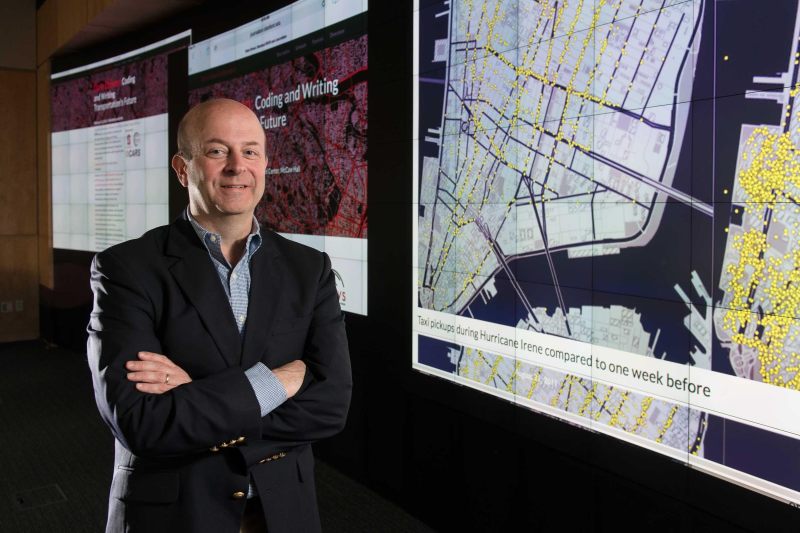
With the recent expansion of data journalism, Stanford’s journalism program will officially open a new computational journalism lab in September and will continue to offer the five new classes that began last fall.
According to Jay Hamilton, Hearst Professor of Communication and director of Stanford’s journalism program, data analysis has become hugely relevant to the media industry over the past decade, and journalists have had to pore through big data in order to find otherwise hidden stories.
Focusing on investigative and computational journalism
Courses such as Public Affairs Data Journalism I, Public Affairs Data Journalism II, Computational Methods in the Civic Sphere, Computation Journalism and Becoming a Watchdog were first offered last year and have curricula that focus on investigative reporting and serving the public by looking through data, especially that produced by the government.
The courses were developed and taught by Hearst Professional in Residence Cheryl Phillips from The Seattle Times and Stanford journalism lecturer Dan Nguyen. The classes have been open for the past year and, according to Phillips, made Stanford one of the first schools to teach journalists how to find stories in data.
“Stanford can be a leader in the new field of computational journalism,” Hamilton said. “There are so many people here who are trying to focus on this question of how can you use larger amounts of data, new algorithms and knowledge from social science to help journalists produce more of accountability or public affairs reporting.”
Hamilton also spoke about the importance of investigative journalism in the media today since the public remains “rationally ignorant,” as explained by economist Anthony Downs M.A. ’56 Ph.D. ’56. According to Downs, since a single vote has such a small statistical significance, citizens don’t take the time to extensively understand public policy. Hamilton explained that it is the job of journalists to use investigative journalism to cover these issues ignored by the public.
The new lab opening in September will be a collection of the researchers, students, journalists, projects and classes dedicated to using data in journalism. Hamilton hopes that the lab will draw the attention of not only journalists but also other professionals, and that it will assist in advancing journalism at the intersection of other fields — most prominently, computer science.
“We hope the lab will be a hub so that we’ll be able to surface the problems that journalists are worried about right now,” Hamilton said.
“We hope to attract the attention of computer scientists, political scientists — other people who are using data — attract their attention to the problems of journalism,” he added.
Besides using data for investigative journalism, the lab and classes also focus on how to personalize stories to fit the demands of readers. As the internet has made information easily accessible to users, journalists must find and write about what the general public can’t learn on their own.
“If the site knows things about you — that you know the difference between Sunni and Shia, knows that you like to see documents as well as videos, knows what you’ve consumed already about a story — if you can combine all of that, there would be a reason for you to go one site over another,” Hamilton said.
Hamilton, Phillips, Nguyen and others are also working on the development of the computational journalism curriculum and are looking for ways to teach data visualization and reader engagement
“Journalism in the public interest is certainly a goal of the program,” Phillips said. “That said, data journalism can just do fun things, too. If you want to be a journalist today and you want to be able to find some good jobs, then you need to be able to have these skills. It will help you find better jobs because it’ll help you tell better stories.”
Redefining the role of journalists
Phillips and Nguyen incorporate projects into their classes to provide students with real-life applications of the data journalism skills.
In Phillips’ Becoming a Watchdog course, she and co-instructor William Behrman, director of the Institute for Computational and Mathematical Engineering’s Stanford Data Lab, ensured that teams had a couple of journalists and at least one engineer. The assigned stories each had an investigative focus.
Ph.D. student in computer science Arun Chaganty and his groupmates worked on a story that involved researching worker conditions in American and European factories in Bangladesh and making sure the organizations met safety requirements.
According to Chaganty, he knew nothing about journalism before taking the class but was interested in the course because it intersected with his main area of study, computer science.
“I’m in general interested in information familiarization, and there’s a lot about information dissemination to do,” Chaganty said. “I wanted to understand how the journalistic process worked — whether there were avenues for me to build tools for journalism.”
Chaganty recalled that although the members of his group stuck to their own specialties early on in the course, when all the data had been found and sorted, the communication students joined Chaganty in using Tableau, a visualization tool, to organize the data and find which Bangladesh factories weren’t up to par. Chaganty also participated in the writing of the story itself.
According to Phillips, this kind of teamwork models that seen in real newsrooms. She explained that students must learn the basic skills for niches beyond their own.
Jessica Park M.A. ’15 enjoyed courses Public Affairs I and Public Affairs II, taught by Nguyen and Phillips, respectively. She had never considered data journalism to be its own niche until she took the classes. While she has always been interested in broadcast journalism, Park explained that she can combine the two areas of journalism to make great stories.
“A lot of journalists and a lot of journalism students, especially the ones I went to school with — we were not big fans of numbers and math,” Park said. “But learning that numbers aren’t really that daunting, that numbers could tell a story where you make it personable, make it about a person rather than the number itself — it definitely made me more interested in wanting to go into data journalism.”
Park spoke about how each day at her current internship at Investigative Reporters and Editors, she uses Structured Query Language (SQL), a programming language and skill she learned in the Stanford computational journalism classes.
Applications in the newsroom
Phillips explained that this year, students will also be able to contribute to a project used in real-world newsrooms. As part of the California Civic Data Coalition, the Stanford Computational Lab will partner with other organizations, including the Los Angeles Times, to analyze campaign funding data. The Coalition was recently awarded $250,000 by The Knight Foundation to develop tools to help analysts to better understand the data.
“We’ll be able to have Stanford students be paid to work on the project,” said Los Angeles Times database producer Ben Welsh. “They’ll be doing things like contributing computer code, or [working on the] open source code base — that’s untangling of the data.”
“You’re asked to use our data to do some journalism, to build your skills as a data analyst,” he added. “It could also mean partnering with academics and professors at Stanford to use that data to try to develop investigative algorithms and mathematical tools.”
While many students like Park may not have initially considered the applications of data in journalism, Hamilton explained that the media industry is currently looking for people who have broad skillsets.
“Data journalism is a very popular thing on hiring boards now,” Hamilton said. “There has always been a part of journalism focused on public affairs, and if you learn these data journalism skills, you’ll be able to still do something different in a way that’s of value.”
Contact Malini Ramaiyer at malu.ramaiyer ‘at’ gmail.com.
